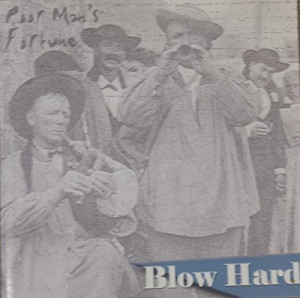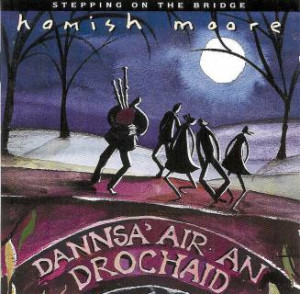 Some of the best Celtic music out there is that released by the bands directly – as are two of the three recordings under consideration here. They might be somewhat difficult to locate, but they’re worth your time to find!
Some of the best Celtic music out there is that released by the bands directly – as are two of the three recordings under consideration here. They might be somewhat difficult to locate, but they’re worth your time to find!
Blow Hard is by Poor Man’s Fortune, a five-piece band featuring almost every instrument in the Celtic tradition. This Texas-based group is one of the few I’ve heard that relies successfully on the Breton tradition. For example, “Dañs Plinn” is from a set from the Plinn region of central Brittany. The set is played in a contradance “call and response” form, in which the bombarde plays the first phrase with the pipes and fiddles stopping on the repeat, then picking up the melody again on the last notes of the repeat, and continuing in this pattern throughout the set.
Poor Man’s Fortune is a raggedy rawney sort of band well suited to this music. Serge Laîné is a native of Roanne, Central France, who sings in French, Occitan, and – conveniently – Breton, and plays accordion, lowland pipes, bass, and dulcitare. Larry Rone plays wooden flutes in D, bombardes, and whistle. Heather Gilmer plays the Irish fiddle; Mark Stone is a vocalist and plays both bodhran and keyboards. Wolf Loescher has been a member of several of Texas’s better known Celtic ensembles, including SixMileBridge, Silver Thistle Pipes and Drums, and Two O’Clock Courage; he is a first-rate vocalist, highland bagpiper and percussionist. I find it to be a style similar to that of Blowzabella as it has the same Anglo-French feel that they often had. This is neither Irish nor Breton, but something that takes the best from both.
Not that Poor Man’s Fortune isn’t capable of a more than decent Irish tune – check out their version of “Up Against the Buachaláns” from Brendán Breathnach’s pivotal Irish music series, Ceol Rince na hÉireann (Dance Music of Ireland). (Short aside – check GMR’s review of Brendán Breathnach’s Folk Music and Dances of Ireland. Our reviewer Laurie Thayer notes: “This book is an amazingly detailed study of every aspect of Irish traditional music.”) According to notes in the CD, “Buachalán” is Irish Gaelic for “ragweed.” So, “[b]eing ‘up against’ them refers to being face down in a field of them in an unsuccessful attempt to make it home after one too many at the pub.”
The other cut I’ll mention is “Tar Road to Sligo,” a jig from the northwest of Ireland. Sligo has produced some of the country’s finest flute players including Tom Byrne, Richie Stafford, and Eddie Cahill, and as a result has some of the best flute-centered jigs one could hope to hear! Suffice it to say that any lover of good, danceable Celtic music should check out Blow Hard. You can learn more about Poor Man’s Fortune by going to their Web site.
 Sliding from Breton-influenced Celtic, we move onto Tidings of Comfort and Joy, a very rare recording by The Mollys, one of the best Mexican/Celtic bands one could hope to hear. (Actually, it’s the only Mexican/Celtic band I’ve ever heard of!) GMR has reviewed a number of releases by The Mollys (including Hat Trick, Trouble, and this is my round), and I’ve seen them live a few times. Unlike later recordings in which the Mexican influence creeps into almost everything the group does, Tiding of Comfort and Joy has a largely Irish feel. That’s not surprising given that Nancy McCallion is justifiably proud of her Scottish-Irish heritage, but it is the Mexican heritage of Catherine Zavala that eventually came to have more and more influence on the band. The later releases by the Mollys very nicely showed an ever-present melding of Mexican and Celtic influences – definitely not the case here. (The Mollys Web site notes Catherine Zavala left the band in March of ’00. This is a real shame as the band benefited immeasurably from her presence, to the point that it’s impossible to think of the band without her.)
Sliding from Breton-influenced Celtic, we move onto Tidings of Comfort and Joy, a very rare recording by The Mollys, one of the best Mexican/Celtic bands one could hope to hear. (Actually, it’s the only Mexican/Celtic band I’ve ever heard of!) GMR has reviewed a number of releases by The Mollys (including Hat Trick, Trouble, and this is my round), and I’ve seen them live a few times. Unlike later recordings in which the Mexican influence creeps into almost everything the group does, Tiding of Comfort and Joy has a largely Irish feel. That’s not surprising given that Nancy McCallion is justifiably proud of her Scottish-Irish heritage, but it is the Mexican heritage of Catherine Zavala that eventually came to have more and more influence on the band. The later releases by the Mollys very nicely showed an ever-present melding of Mexican and Celtic influences – definitely not the case here. (The Mollys Web site notes Catherine Zavala left the band in March of ’00. This is a real shame as the band benefited immeasurably from her presence, to the point that it’s impossible to think of the band without her.)
What I like best about this recording is the aggressive working-class Irishness of it – traditional songs “Finnegan’s Wake,” “Drill Ye Tarriers” and “Lanigan’s Ball” are given an FHL (faster harder louder) treatment that makes them regain their freshness. The anti-war song set, “Johnny Has Gone for a Soldier/Johnny I Hardly Knew You,” also benefits from a rougher treatment than that given in later recordings. As Richard Dansky noted in his review of their song, “Johnny Will You Cross,” on their this is my round CD, “Catherine Zavala and Nancy McCallion’s vocal harmonies work even better here than on some of the rougher-edged pieces, and the instrumentation is tastefully understated, with guitar and accordion taking turns to come respectfully to the fore.”
The CD ends with a cover of “God Rest Ye” that has been given new lyrics by Nancy McCallion which are every bit as angry as one might expect after hearing their renditions of the aforementioned “Finnegan’s Wake” et al. Unfortunately, this CD is long out of print – one can only hope the Mollys will re-release it soon!
 Hmmm… What else is in the vast pile of Celtic CDs that need reviewing? Ah, here’s a recording worth talking about: Hamish Moore’s Dannsa’ Air An Drochaid, a 1997 release from Greentrax. It’s not a self-released CD, but Greentrax is a family-run business that has kept the spirit of being rooted in the music.
Hmmm… What else is in the vast pile of Celtic CDs that need reviewing? Ah, here’s a recording worth talking about: Hamish Moore’s Dannsa’ Air An Drochaid, a 1997 release from Greentrax. It’s not a self-released CD, but Greentrax is a family-run business that has kept the spirit of being rooted in the music.
In an essay on Dance Forms in Gaelic Music, we have this note: “Hamish Moore, who has contributed so much to the restoration of true Highland music, states in the liner notes to his landmark recording Dannsa air an Drochaid (Stepping on the Bridge): ‘When we lost the step dancing, we lost the need to play the music as it is played at the dances in Glencoe Mills in Inverness County in Cape Breton today. In particular we lost the old way of playing the strathspey, or the strathspey reel, as they were known. Most of these old strathspeys have very primitive melodies, the tune being dependent on the rhythm. If the rhythm is taken away, there is very little left.'”
This is an album of strathspeys by Hamish on his Scottish smallpipes. Hamish notes in his liner notes – which are equal to those written by fellow Scotsman Brian McNeill in their level of excellence – that “… seeds of this album were sown in 1987 when I first heard [Cape Breton fiddler] Buddy MacMaster and Maybelle Chisholm playing at a music festival in Philadelphia….” He goes on to claim that Cape Breton fiddlers are reasonably true to the 18th-century Highland style. And Hamish is a smart enough musician to know that music evolves or it dies, so the different paths that Scottish and Cape Breton music took over the centuries have created meaningful differences.
Adapting Cape Breton fiddling music to the Scottish small pipes is not that difficult, as pipers and fiddlers speak a common language. Watch them play together at a ceilidh if you don’t believe me! (I’m not so sure about bodhran players!) David & Hamish Moore are makers of fine Scottish bagpipes, and by the end of 1998 they had supplied well over 500 sets to customers in the UK, US, Canada, Europe, New Zealand, Australia and Hong Kong. Their Web site notes that the design of the small pipes is based on an original 19th century set which, in 1980, was the first set to be restored during the current revival of this instrument, heard on Hamish’s first record, Cauld Wind Pipes.
Enough background. Hamish plays High Pipes, Border Pipes, and – naturally – Scottish smallpipes. He’s joined by Hilda Chisholm playing the piano, the legendary Jerry Holland on fiddle, and Paul McDonald on guitar. There’s nothing flashy here – just straightforward, lively piping, fiddle, and piano playing. Okay, there are a few additional musicians: Ian Hardie of Old Blind Dogs fame plays viola on “Mrs Hamilton,” which is also where you’ll find Wendy Weatherby playing the cello; Rod Paterson offers a delightfully comic vocal of “Stumpie” which Hamish thinks was the source of the modern march “Highland Wedding”; and “Jack Daniel’s” features a Moving Hearts style of soprano sax playing by Dick Lee.
This is more traditional than Hamish’s previous releases, but well-suited to the “dance music” that he’s trying – quite successfully – to pay homage to. It’s as joyous as all of his other releases are, if a tad more restrained. But then I think all Cape Breton music is more “formal” sounding that modern Scottish Celtic music. There’s no doubt that this is an album worth purchasing – I certainly will cherish it!
(Poor Man’s Fortune, 1999)
(The Mollys, 1992)
(Greentrax, 1997)
